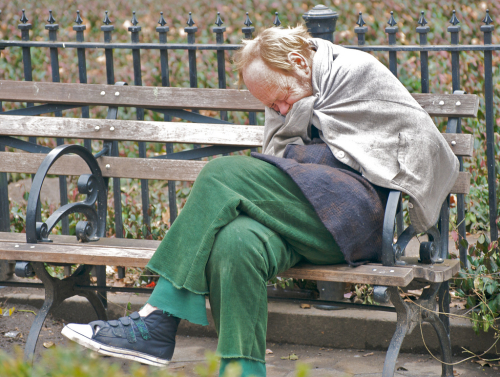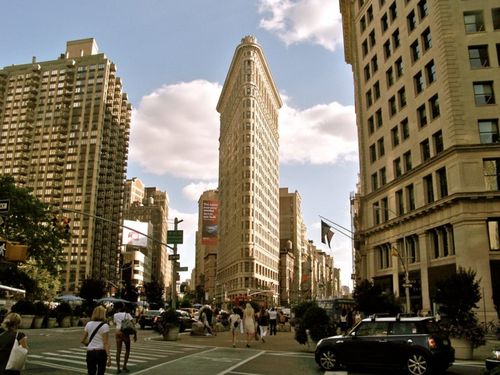
"Homeless and cold" by Ed Yourdon, taken January 25, 2010 in Verdi Square, 72nd Street and Broadway, New York
CITY JOURNAL
July 21, 2014
How to help the Mentally Ill?
by James Panero
A New York City task force could repeat the mistakes of deinstitutionalization.
Early last February, Jerome Murdough, homeless and seeking shelter from freezing temperatures, was arrested for trespassing in the stairwell of an East Harlem housing project. Unable to post his $2,500 bail, the 56-year-old Marine veteran with a history of mental illness remained in police custody. A week later, on the evening of February 14, he was transferred to a solitary cell in the mental-observation unit of New York City’s Rikers Island jail complex. Guards were supposed to check on Murdough every 15 minutes, but he was not fully observed until early the next morning, when it became apparent that a malfunction in the prison’s climate-control system had heated his 6-by-10-foot cinder-block room into the triple digits. When discovered slumped over his bed, Murdough’s lifeless body registered a core temperature of more than 100 degrees.Headlines blared that Murdough had been “Baked to Death on Rikers Island.”
Murdough’s gruesome death prompted New York City mayor Bill de Blasio to announce his first major law-enforcement initiative, the Task Force on Behavioral Health and the Criminal Justice System. Set to issue findings this September, it will seek recommendations from city police, judges, district attorneys, and mental-health workers on “innovative strategies to transform, reform and update this city’s criminal justice system.” In a statement, de Blasio said that the task force will allow the city to “provide real, lasting mental health and addiction treatment” for the city’s mentally ill. “For far too long,” he continued, “our city’s jails have acted as de facto mental health facilities.”
The mayor is right that the criminal-justice system dedicates inordinate resources to policing mental illness, often with disgraceful results. In this regard, New York’s experience mirrors that of much of the country. A 2010study by the Treatment Advocacy Center (TAC) found that there were “three times more seriously mentally ill persons in jails and prisons than in hospitals.” Sheriffs’ associations estimate that the mentally ill make up over a quarter of inmates in their jails. According to E. Fuller Torrey, the founder of TAC, the Los Angeles County Jail has become the largest de facto inpatient psychiatric facility in the United States. Rikers Island is the second-largest.
It shouldn’t require a task force to understand why. The vast incarceration of the mentally ill is a consequence of the 50-year-old policy of deinstitutionalization—the closing of state mental asylums and the reduction of hospital beds set aside for the mentally ill. Lacking both the medical resources and legal framework to care properly for the severely mentally ill, the community-based system meant to replace it was never equipped to give true “asylum” to those patients unable to cope in regular society. As a result, those most in need of help often wind up revolving among outpatient facilities, homeless shelters, and the streets. Arrest and prosecution offered the only remaining method of sequestering the violent and delusional and preventing them from harming themselves and others.
Unfortunately, early indications suggest that the city’s new task force could actually make things worse. Just as government planning failed to account for the catastrophe of deinstitutionalization, a new decriminalization initiative could lead to the mentally ill being pushed back into the subway system and the open-air asylums of Broadway and Central Park. This would represent a shameful return to the status quo of the early 1990s, before quality-of-life policing began under Mayor Rudolph Giuliani.
Each year, the NYPD receives 100,000 calls concerning “emotionally disturbed persons.” Elizabeth Glazer, the mayor’s criminal-justice coordinator and a leader of the task force, asks, “If someone picks up the phone and calls 911 because they see someone acting out on the street, then what does the police officer do?” Of all possible answers to this question, “leave them on the streets” seems to be the worst. Yet civil libertarians may use the task force cops to do just that, undermining proactive policing and the right of New Yorkers to live without the terror of unstable people undergoing psychotic breakdowns in public.
Instead, the task force should strengthen the state’s ability to compel the mentally ill to pursue proper treatment—for instance, by widening the use of Kendra’s Law, named after Kendra Webdale. In 1999, Andrew Goldstein, a schizophrenic who had stopped taking his medications, pushed Webdale to her death beneath a subway train. Kendra’s Law, which the ACLU opposed, gave New York courts the power to compel the mentally ill to accept treatment as a condition of living in society. According to D.J. Jaffe of Mental Illness Policy Org., Kendra’s Law reduces incarceration by 87 percent. By applying it to all prison inmates upon their release, the law would reduce reincarceration as well.
Another constructive measure would be to improve the mental-health services offered within the prison system, while revisiting the idea of asylums. Since prisons have become makeshift mental institutions, such an effort would have immediate results. But incarceration will always be an inefficient and inhumane method of caring for the mentally ill compared with purpose-built institutions. “The simple claims of a common humanity,” wrote Thomas Story Kirkbride, the progressive architect of the nineteenth-century asylums, “should induce every State to make a liberal provision for all its insane, and it will be found that it is no less its interest to do so, as a mere matter of economy.” Until New York comes to terms with the failure of deinstitutionalization, the criminalization of mental illness will never be cured.
